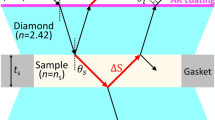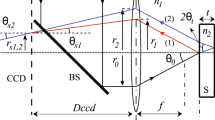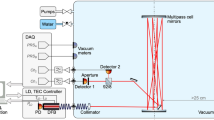Abstract
IT is well known that the density of a material depends on its method of preparation and subsequent treatment. Values of the densities of bulk materials treated in various ways are given in reference tables1. Increasing use is, however, being made of materials in the form of thin evaporated films, and in some experiments, such as those involving measurements of transmission or energy loss with atomic particles, the superficial density of the film is a more significant parameter than its linear thickness. It is not always possible to measure the superficial density sufficiently accurately by direct weighing. A knowledge of the density of the evaporated material is needed for the superficial density of the film to be calculated from its linear thickness, measured, for example, by multiple beam interferometry2–4. Observations5 on silver films in which the mass of silver was estimated by a chemical colorimetric method accurate to 3 per cent gave agreement between the density of the film and the bulk density. For aluminium, however, the oscillating quartz crystal thickness monitor described by Lawson6 gave an observed thickness sensitivity some 4 per cent greater than the theoretical sensitivity. The thickness sensitivity, measured as the shift in frequency/unit linear film thickness, is directly proportional to the density of the evaporated material. The early measurements by Kahlbaum7 seem to have been made with massive samples recast from vacuum distilled material. We report here the results of direct determinations of the density of some metallic films. The linear thicknesses were determined by multiple beam interferometry and the superficial densities were measured gravimetrically.
This is a preview of subscription content, access via your institution
Access options
Subscribe to this journal
Receive 51 print issues and online access
$199.00 per year
only $3.90 per issue
Buy this article
- Purchase on Springer Link
- Instant access to full article PDF
Prices may be subject to local taxes which are calculated during checkout
Similar content being viewed by others
References
Smithsonian Physical Tables, ninth ed. (1954).
Tolansky, S., Multiple Beam Interferometry (Clarendon Press, Oxford, 1948).
Tolansky, S., Surface Microtopography (Longmans, 1960).
Scott, G. D., McLauchlan, T. A., and Sennett, R. S., J. App. Phys., 21, 843 (1950).
Donaldson, W. K., and Khamsavi, A., Nature, 159, 228 (1947).
Lawson, W. H., J. Sci. Inst., 44, 917 (1967).
Kahlbaum, G. W. A., Phys. Zeit., 3, 32 (1901).
Kay, G. W. C., and Laby, T. H., Tables of Physical and Chemical Constants, thirteenth ed. (Longmans, 1966).
Author information
Authors and Affiliations
Rights and permissions
About this article
Cite this article
LOVELL, S., ROLLINSON, E. Density of Thin Films of Vacuum Evaporated Metals. Nature 218, 1179–1180 (1968). https://doi.org/10.1038/2181179a0
Received:
Issue Date:
DOI: https://doi.org/10.1038/2181179a0
This article is cited by
-
Size dependence of the bulk modulus of Si nanocrystals
Sādhanā (2018)
-
Effects of size on mass density and its influence on mechanical and thermal properties of ZrO2 nanoparticles in different structures
Bulletin of Materials Science (2016)
-
Pharmacological control of osteoclastic motility
Calcified Tissue International (1983)
-
Density of Copper Thin Films measured by X-ray Absorption
Nature (1968)
Comments
By submitting a comment you agree to abide by our Terms and Community Guidelines. If you find something abusive or that does not comply with our terms or guidelines please flag it as inappropriate.



